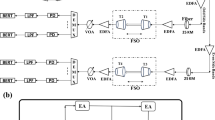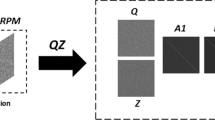Abstract
In this paper, the theoretical bit error rate (BER) of N-level pulse amplitude modulation (PAM-N) and M-ary quadrature amplitude modulation (M-QAM) have been studied and compared under different scenarios, including (i) PAM with intensity modulation with direct detection (IM/DD) and field modulation with detection (FMD) (including coherent detection and single-sideband modulation with direct detection (SSB-DD)), and (ii) QAM with coherent detection and SSB-DD. Considering the relationship between the symbol spacing and signal-to-noise ratio (SNR), we provide the mathematical BER equations, including the optical signal-to-noise ratio (OSNR) and carrier-to-signal power ratio (CSPR), especially for PAM signals. To verify the validity of our theoretical expressions for SSB systems, transmissions with 224-Gb/s SSB-PAM4/16QAM signals using the Kramers-Kronig (KK) receiver were implemented on a unified optical system platform. The simulation results agreed well with theoretical calculations both in back-to-back (BtB) and 120-km transmission scenarios, which showed that the BER evaluation methods can serve as a theoretical guidance and system assessment criteria for SSB scenarios.
Similar content being viewed by others
References
Zhong K P, Zhou X, Huo J H, et al. Digital signal processing for short-reach optical communications: a review of current technologies and future trends. J Lightwave Technol, 2018, 36: 377–400
Zhang X L, Zhang C F, Chen C, et al. Non-optical carrier SSB-OFDM PONs with the improved receiver sensitivity and potential transmission nonlinearity tolerance. IEEE Photonics J, 2017, 9: 1–10
Zhu M Y, Zhang J, Yi X W, et al. Optical single side-band Nyquist PAM-4 transmission using dual-drive MZM modulation and direct detection. Opt Express, 2018, 26: 6629–6638
Zhu Y X, Zou K H, Chen Z Y, et al. 224 Gb/s optical carrier-assisted Nyquist 16-QAM half-cycle single-sideband direct detection transmission over 160 km SSMF. J Lightwave Technol, 2017, 35: 1557–1565
Le S T, Schuh K, Chagnon M, et al. 1.72-Tb/s virtual-carrier-assisted direct-detection transmission over 200 km. J Lightwave Technol, 2018, 36: 1347–1353
Zhang X L, Zhang C F, Chen C, et al. Digital chromatic dispersion pre-management for SSB modulation direct-detection optical transmission systems. Optics Commun, 2018, 427: 551–556
Li A, Peng W-R, Cui Y, et al. 112 GBd virtual-carrier assisted single-sideband PAM4 with Kramers-Kronig detection and blind adaptive IQ imbalance compensation. In: Proceedings of Optical Fiber Communication Conference, 2019. 5
Mecozzi A, Antonelli C, Shtaif M. Kramers-Kronig coherent receiver. Optica, 2016, 3: 1220–1227
Mecozzi A. A necessary and sufficient condition for minimum phase and implications for phase retrieval. 2016. ArXiv:1606.04861
Li Z, Erkilinc M S, Shi K, et al. SSBI mitigation and the Kramers-Kronig scheme in single-sideband direct-detection transmission with receiver-based electronic dispersion compensation. J Lightwave Technol, 2017, 35: 1887–1893
Lu J H, Letaief K B, Chuang J C I, et al. M-PSK and M-QAM BER computation using signal-space concepts. IEEE Trans Commun, 1999, 47: 181–184
Yang L-L, Hanzo L. A recursive algorithm for the error probability evaluation of M-QAM. IEEE Commun Lett, 2000, 4: 304–306
Szczerba K, Westbergh P, Karout J, et al. 4-PAM for high-speed short-range optical communications. J Opt Commun Netw, 2012, 4: 885–984
Szczerba K, Westbergh P, Agrell E, et al. Comparison of intersymbol interference power penalties for OOK and 4-PAM in short-range optical links. J Lightwave Technol, 2013, 31: 3525–3534
Chagnon M, Osman M, Poulin M, et al. Experimental study of 112 Gb/s short reach transmission employing PAM formats and SiP intensity modulator at 13 µm. Opt Express, 2014, 22: 21018
Lu D X, Lau A P T, Lu C, et al. Theoretical CSPR analysis and performance comparison for four single-sideband modulation schemes with Kramers-Kronig receiver. IEEE Access, 2019, 7: 166257–166267
Antonelli C, Mecozzi A, Shtaif M. Kramers-Kronig PAM transceiver and two-sided polarization-multiplexed Kramers-Kronig transceiver. J Lightwave Technol, 2018, 36: 468–475
Li X, Luo M, Li C, et al. Direct detection of pilot-assisted PAM-4 signals with large phase noise tolerance. Opt Lett, 2019, 44: 5457–5460
Bo T W, Kim H. Kramers-Kronig receiver without upsampling. In: Proceedings of Optical Fiber Communication Conference, 2018. 2
Zhou X, Lu C, Lau A P T, et al. Low-complexity carrier phase recovery for square M-QAM based on S-BPS algorithm. IEEE Photon Technol Lett, 2014, 26: 1863–1866
Zhou X, Zhong K P, Gao Y L, et al. Modulation-format-independent blind phase search algorithm for coherent optical square M-QAM systems. Opt Express, 2014, 22: 24044–24054
Sun C, Che D, Ji H L, et al. Study of chromatic dispersion impacts on Kramers-Kronig and SSBI iterative cancellation receiver. IEEE Photon Technol Lett, 2019, 31: 303–306
Zhu M Y, Zhang J, Huang X T, et al. Influence of EEPN and P2A noise with CD pre- and post-compensation in optical SSB transmission and Kramers-Kronig receiver system. Opt Express, 2019, 27: 19664
Le S T, Schuh K. Experimental verification of equalization enhanced phase noise in Kramers-Kronig transmissions. In: Proceedings of Optical Fiber Communication Conference, 2019. 2
Acknowledgements
This work was supported by National Key Research and Development Program of China (Grant No. 2019YFB1803905), National Natural Science Foundation of China (Grant Nos. 61871030, 61671053), Fundamental Research Funds for the Central Universities (Grant No. FRF-MP-19-009), State Key Laboratory of Advanced Optical Communication Systems Networks, China, Open Fund of IPOC (BUPT) (Grant No. IPOC2018B009), and Foundation of Beijing Engineering and Technology Center for Convergence Networks and Ubiquitous Services.
Author information
Authors and Affiliations
Corresponding author
Rights and permissions
About this article
Cite this article
Lu, D., Zhou, X., Yang, Y. et al. Theoretical analysis of PAM-N and M-QAM BER computation with single-sideband signal. Sci. China Inf. Sci. 64, 182312 (2021). https://doi.org/10.1007/s11432-020-3025-4
Received:
Revised:
Accepted:
Published:
DOI: https://doi.org/10.1007/s11432-020-3025-4




